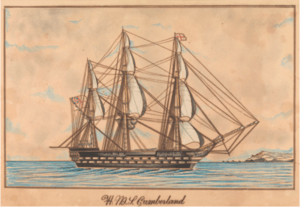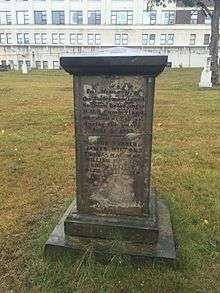HMS Cumberland (1842)
 H.M.S. Cumberland, c.1852 | |
| History | |
|---|---|
| Name: | HMS Cumberland |
| Builder: | Chatham Dockyard |
| Laid down: | April 1836 |
| Launched: | 21 October 1842 |
| Fate: | Burned 17 February 1889 |
| General characteristics [1] | |
| Class and type: | 70-gun third rate ship of the line |
| Tons burthen: | 2214 bm |
| Length: | 180 ft (55 m) (gundeck) |
| Beam: | 54 ft 3 in (16.54 m) |
| Depth of hold: | 22 ft 4 in (6.81 m) |
| Propulsion: | Sails |
| Sail plan: | Full rigged ship |
| Armament: |
|
HMS Cumberland was a 70-gun third rate ship of the line of the Royal Navy, launched on 21 October 1842 at Chatham Dockyard.[1] She carried a crew of 620 men.
Cumberland recommissioned as a flagship under Captain George Henry Seymour as the flagship of his father, Vice-Admiral Sir George Francis Seymour. She served on the North America and West Indies Station.[2] In March 1854 she sailed to the Baltic Sea as the Crimean War with Russia was imminent. Cumberland was involved in the Battle of Bomarsund, an Anglo-French attack on Bomarsund in the Grand Duchy of Finland in August 1854.[3]
Cumberland was converted to serve as a training ship in 1870. She was destroyed by fire on the River Clyde in Scotland on 17 February 1889.[1][4]

Monument to the 6 crew of HMS Cumberland that died at Halifax, Royal Navy Burying Ground (Halifax, Nova Scotia)
Notes
References
- Lavery, Brian (2003) The Ship of the Line - Volume 1: The development of the battlefleet 1650-1850. Conway Maritime Press. ISBN 0-85177-252-8.
This article is issued from
Wikipedia.
The text is licensed under Creative Commons - Attribution - Sharealike.
Additional terms may apply for the media files.